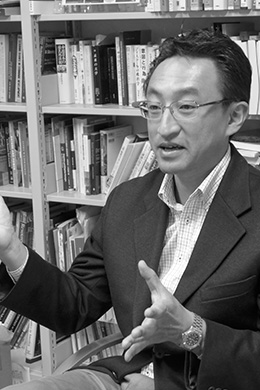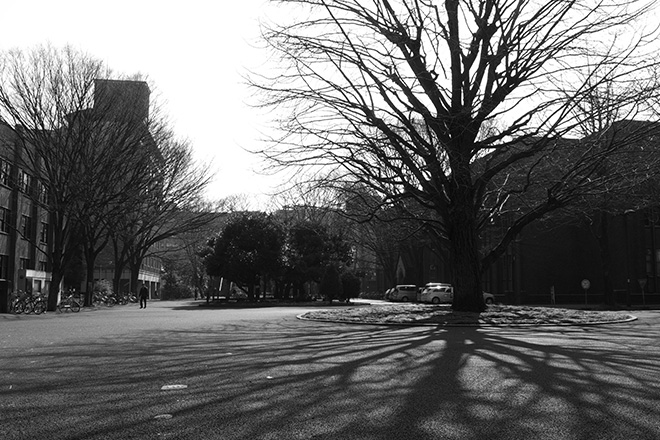Constructing a Framework Centered on Resources for a New Society
Jin Sato / Professor Department of Pioneering Asian Studies, Institute for Advanced Studies on Asia, University of Tokyo.

——— Professor Sato, your expertise is in resources, but you also approach the subject from an historical approach. What is it that interests you?
Sato: My ultimate interest is “wealth and poverty in human society.” I believe that resources spur on and play an intermediary role in such conditions. Maybe you have resources but can’t access them, maybe you had them but somebody took them from you, or maybe you found something that you did not think was there. Human cooperation or non-cooperation, scientific discoveries, and myriad factors act to enlarge or shrink resources. That’s what I think; I think that resources lie directly at the center, whether from an environmental protection perspective or from that of improving living standards for humans.
There are dilemmas, such as development vs. environment, but the common item that lies in the middle is resources. I think that it’s more likely that unbalanced usage causes environmental problems and poverty, so I have been wanting to construct a new framework with resources at the center. Then, it has increasingly become clear that many Japanese people have already also been thinking about this.
——— That’s why you have been conducting the interviews. Even if documents are found, it is becoming increasingly difficult to hear the firsthand accounts that led to the documents and to understand through perspectives of the people who had actual knowledge about the times in which they took place.
Sato: Historically, people noted all types of things. They would often store those notes somewhere at the back of the house or in a storage space, and when the people passed away, the notes would then be thrown away. However, what should have been left behind is the whole package, including the notes that denoted the person’s thoughts plus the memos or items that were noted down or collected by that person. But quite often, the family of these people did not understand the value of such things. They would see it as, “Oh, dad is writing down some strange stuff again.”
However, I have no particular notion of having such an historical approach. Policies are often things that “we knew about but couldn’t do.” If a policy was known but could not be implemented, then the likelihood is that the policy was not utilized because of some reason or cause. This begs the question, “Why was such a framework constructed that prohibited us from utilizing something that we knew? Who built that framework and when? Was there an alternative proposal?” These questions led me to think that one must research the background on how the preconditions for this framework were built in order to create policies with true significance. So, for me, this was a very straight forward approach; however, when I looked around, I didn’t find anyone else pursuing this path.
I think it is also an aspect of my personality. Just as an example, when I hear words, such as “resource,” I am motivated to trace the words back to the initial periods when Japanese people started using them. Maybe I have a bit of an historical spirit in me.

——— What is something that you are currently engaged in?
Sato: I would like to write a book on how to evaluate the problems of development and the issues involving our environment throughout the world. In terms of research, many nations in Southeast Asia have been developing administrative systems to govern resources and the environment. One country will first manage the water, then forests, then minerals, and then the air. However, if you go to another country, their uses may be in a different order, and that creates tensions with those people in the targeted areas. Also, I am thinking about how the mechanisms on how to resolve these tensions differ by nation or region. Another topic to consider is how to disseminate research outcomes. I have decided that academic work will be written in English, and I think that, besides this, I want to issue a compact book summarizing what I have been working on until now with a view to publishing it this summer.
Then there is the comparative research that I would like to conduct on resource governance, but hardly anyone is involved in this. Historically speaking, this is the colonial era because most of the systems in Asia were built during the colonial era. So, depending on which nation was administrating in that area, the differences in starting points may be vast. The norm in the field of resources is one nation, one resource. So, you may find people who say, “I’m studying forests in Thailand” or “I’m studying water in Indonesia,” but you hardly find anyone conducting comparative research. If I were to say, “I want to do it all, and, not only that, I want to line them up and see how they are positioned against each other,” people will probably say, “You have got to be kidding!” (Laughter)
——— At GSDM (Global Leader Program for Social Design and Management), we aim to develop people who know about technology and understand public policy or engineers that understand public policy. Isn’t it very difficult for today’s students to acquire the type of approach that you have?
Sato: I think I’m very lucky to have somehow made a living on this, but I don’t think that there have to be several people who do this sort of thing. It isn’t for everyone; in other words, it isn’t suited for mass production. So, really, I think it is fine if there is only 1 out of 10 or maybe 0.5 out of 10
What is definitively important for social science is to describe the entire picture, rather than carefully studying the parts. I think the true thrill in social science lies in showing that “the overall picture looks like this” or indicate various turning points or say this is the turning point. I think that it is a crucial function for society. Not that everyone should be doing that, because not everyone is suited to that task. It would be great, however, if GSDM could yield such people. I am not really sure though, if training makes it possible; I’m not sure about taking someone without a natural affinity and hitting them on the head with a textbook, shouting, “Look at the big picture!”

——— I hear that you also teach at Princeton University in the United States. There is the obvious language difference, but what about the lecture content or atmosphere? Are there other differences?
Sato: Let’s see. There is an overall weight of the session; it seems as though the energy they put toward each session over there is much greater for the student and the teacher. In a nutshell, the standard volume of reading that is expected in each course is overwhelmingly greater in the U.S., so students are critically assessed on this as well. At Princeton, there is also the issue of undergraduates paying five to six million yen annually so that graduate students can study with little cost to them; consequently, the undergraduates’ satisfaction is quite important. The university is highly concerned about offering courses that will make the undergraduates happy. The teaching staff is essentially more interested in research, but they do not cut corners in teaching; hence, the provided training is good.
The last time that I taught at Princeton was at the department of East Asian Studies. This is the first time, however, that I am invited to teach at the public policy graduate school, the Woodrow Wilson School. So, this will be my first time there. If I receive good feedback from the students and am requested to return, then I would like to keep returning as long as the university allows. Once the university says that I do not need to come back again, then that’s it. I believe the University of Tokyo has something like a teaching award where teachers with good student feedback receive bonuses. For me, only jelly or sweet cakes would suffice. (Laughter)
